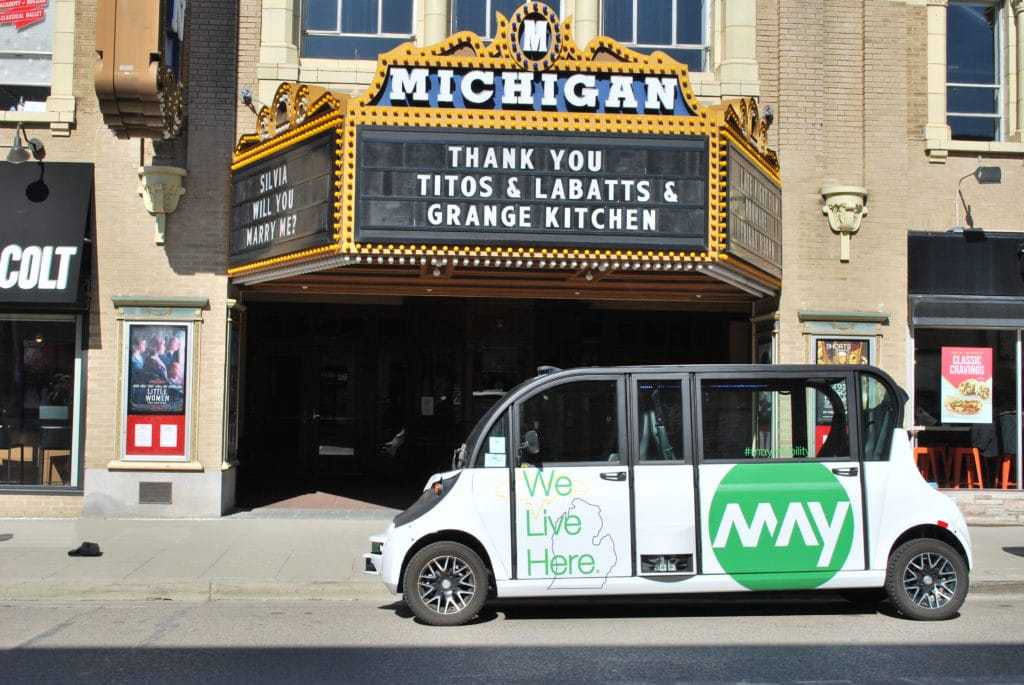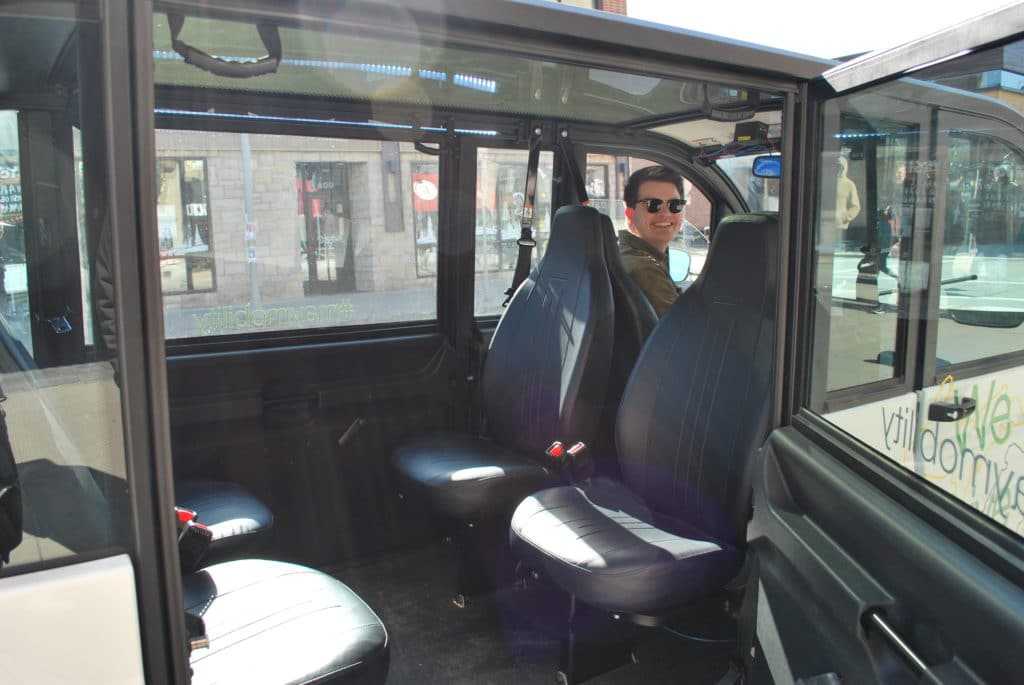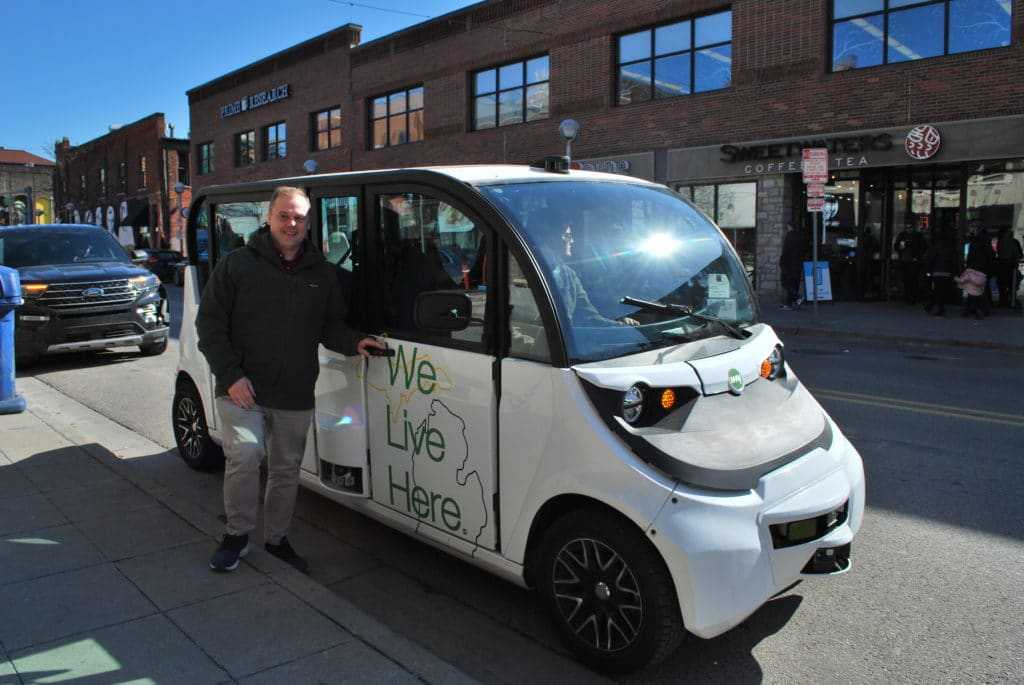The May Mobility shuttle parked in front of the Michigan Theater in Ann Arbor.
"It's a very natural feeling, it doesn't feel as if a robot is driving." Noah is an engineer with May Mobility. He's driving us along with May CEO Ed Olson around downtown Ann Arbor. Pedestrians cut into crosswalks against the light and better judgment, a hallmark of the local student pedestrian-friendly culture. And this autonomous shuttle is not only not hitting them--it's treating them with a lot more deference and a natural-feeling safe distance than you might get from a lot of human drivers.
We could tell you about how the algorithm that is driving this self-driving shuttle feels very comfortable--not jerky, not alarming, and not overly slow, either. It played it safe on the crosswalk, felt like a respectful human driver when faced with surprise pedestrians cutting out into traffic, and didn't hit the unicyclist who popped out of nowhere to cross Liberty. But what struck us about our interview with May Mobility founder and CEO El Olson and engineer Noah is that they already know that isn't the crux of the work they're doing to revolutionize the transportation and mobility industries.
What struck us about our interview with May Mobility founder and CEO El Olson and engineer Noah is that they already know autonomous technology isn't the crux of the work they're doing to revolutionize the transportation and mobility industries.
Autonomous driving is slowly integrating itself into the landscape of the auto industry, and even as customers are still adjusting to the idea of taking their hands off the wheel, companies like May already know the fears, the challenges to safe technology, and the subsequent glamor of the technology will wear off. And then what? What will autonomous driving look like when it's no longer new?
Autonomous engineer Noah monitors the shuttle as it drives itself, hands-off, through downtown streets, comfortable avoiding any obstacles like a human driver would.
There still is a lot to be done to convince people that shuttles and even just plain old EVs are safe, especially after early issues with Google and Tesla vehicles ended up splashed all over the headlines. You accidentally kill a driver or pedestrian with a standard combustion vehicle and you have a tragic and serious problem on your hands for the people involved and possibly the automaker who needs to conduct a recall. You crash an electric car or a self-driving car that hasn't yet proven its technology safe or have a battery pack explode, it can set the entire industry back years in credibility. These things have to be safe. May Mobility knows this, and they already consider safety to be the price of entry. What the real standard is for May and similar companies these days is comfort and ease of use. That's what they say is really the heart of autonomous driving becoming the norm.
"We want to be out in the real world with real customers where we're solving real transit problems for paying customers. We're learning how the technology works in these environments, but we're also learning what customers like," says Olson of the difference between May and many companies who pilot autonomous driving programs in closed track environments before offering these functionalities to the public. The May shuttle's ability to switch to autonomous mode and navigate downtown streets in Ann Arbor is more than functional. It's really impressive, even for this jaded old EV-focused automotive journalist. We quickly relaxed into the ride, much like you would if you could tell a really considerate person was driving your vehicle. No need to worry, at least at these speeds.
We quickly relaxed into the ride, much like you would if you could tell a really considerate person was driving your vehicle. No need to worry, at least at these speeds.
The May Mobility shuttles drive like a tiny bus. Four padded high-backed seats face each other in the back of a short vehicle with a wide door on the side. The safety driver was placed up front, but the steering wheel? Already gone. Emergency backup controls consisted of buttons on a stick that came up between the driver's legs. The driver's seat and passenger seat face a full-cockpit-width screen that contains route information and vehicle data. That's about it. Otherwise, it's a standard mini shuttle bus. Except the seats are a bit more comfy than you might expect, and there's plenty of head room and foot room.
May Mobility CEO Ed Olson stands next to his creation in downtown Ann Arbor, where a May shuttles was programmed to run in a circular route from the University of Michigan campus to Main Street for our interview.
"The headliner is missing on this test vehicle," driver Noah tells us as we ask about differences in features available in test vehicles and those going to market.
"These LEDs are going into the final vehicles in some cases, not all of them," Olson points out of the blue lights lining the roofline inside the glass full panoramic roof, "but for the most part, what you see is what you get."
We can imagine a day in the not too distant future when riders abandon their fear of self-driving shuttles, at least, because these vehicles aren't authorized or designed to be driven above 25 miles per hour anyway and that's an easy speed for test drives. Olson tells us that the vehicle fleets at May could include vehicles designed for highway driving at some point to connect routes, but for the most part the goal here isn't to automate more vehicles, it's simply to create an economic way to fill in gaps in the existing transportation routes of cities. Shuttle buses a primary example.
"Our business model maybe isn't what you might expect," Olson explains.
"Our business model maybe isn't what you might expect," Olson explains. "We sell to municipalities and enterprises," he says, "as opposed to consumers directly. We're dealing with transit planners, VPs of parking and transportation, people who would charter transportation services on behalf of their customers and residents."
In Detroit May was working on a pilot program for commercial service. The program has been operating for 18 months now, carrying people from a cluster of office buildings to parking. "It's not a very sexy route," Olson says, "but we're serving a real transportation problem. We've carried over 100,000 people on that route." The company has expanded to run programs in several other cities as well. So far so good. People love it. Olson says that in a test run with business executives from Detroit, they found themselves so comfortable during the ride that they quickly shifted from marveling over the shuttle to conducting an impromptu meeting during the drive, and realized on arrival to their destination the self-driving feature had saved them time. This was one of our key questions. Will these shuttles carry wi-fi for those busy professionals who want to recapture driving time to work time on a commute? "The shuttles already have wifi," Olson confirms.
Any challenges with that business model? It's a new thing to try to sell self-driving shuttles to transportation managers. "Every customer is different, but [that early Detroit] customer is exciting because they have a large number of routes that they service already," Olson says. "We started out by picking one route that was good for our technology and looked to expand to other routes."
The screen in a May shuttle crosses the entire width of the cockpit, with speed and route information and vehicle data.
We ask about the potential differences in how May might roll out fully autonomous shuttles versus the personal vehicle market, where automakers are gradually shifting from partially self-driving features such as self-parking to more fully autonomous cars as the tech becomes more reliable. "In personally owned vehicles, the economics are a long way from making any sense," Olson says. "To make a Ford Fusion autonomous requires hundreds of thousands of dollars.... We're going for these permanent routes where there is a rider density to support those costs. We don't view the autonomy as a core feature of our service. We view ourselves as a transportation company that uses autonomous technology to provide a better product."
We don't view the autonomy as a core feature of our service. We view ourselves as a transportation company that uses autonomous technology to provide a better product."
So what is the crux of the May model for selling these shuttles in a shifting integrated transportation landscape? "It comes down to headway. The number one things riders care about when riding any transit service is wait time," Olson says. "The challenge is that if you have limited resources, you have to build bigger and bigger buses to carry more and more people, which works if you have the ridership. Usually you don't have the ridership, so you start running the buses less frequently, and that creates longer and longer wait times. We call this the vicious cycle of declining ridership in service. Ridership goes down so you operate your vehicle less frequently, so your ridership goes down. The thing that needs to happen is to reverse that cycle--create a service that's so good that people will choose to use it even if they can afford not to. How can you get more vehicles on the road, reduce the headway? We believe the way to do this is a smaller number of vehicles, but that creates more operational costs especially in terms of drivers. We see autonomy as a key enabler to enable transportation that people will actually use."
"The number one things riders care about when riding any transit service is wait time," Olson says.
So, it's not just about the novelty of self-driving cars, which will surely wear off as the technology improves. It's about another form of transport technology that seems novel to us now, because we're used to self-driving trains only being on tracks at airports, becoming part of the mainstream and integrating into a larger transportation picture. Also, Detroit is well-known to have an issue with declining public transport usage after population declines and reliability issues with the bus service over the years. Olson says that one of the benefits of a shuttle service being the most reliable option for transport is that it brings a city back together again. Business people can ride alongside riders they wouldn't normally interact with, and that creates new connections and a renewed sense of community, rather than people riding their cars through neighborhoods to take them from a private home to a private office.
"You read a lot about how adoption is going to be a real problem for EVs," Olson says, "but that's based on a misconception. If the value proposition is how long is it going to be before people pay tens of thousands of dollars to have an autonomous sedan, it's going to be a long time. What's the value proposition for that? But if the value proposition is you're standing outside, it's cold out, you've been waiting for 15 minutes. An autonomous vehicle comes up, it's warm and ready to go and can get you where you want to go in 2 minutes or you can keep waiting for the bus, adoption is immediate. You can still blow it by providing a bad experience for the rider, but what we found is that by going out and solving real transportation problems, we've found adoption's not the problem. We've had so much interest in the service that we're looking at how can we put more vehicles on the route?"
"So the challenge is for us to create a transportation system that's so good that people who can afford not to use it will use it."
Engineer Noah says that in Grand Rapids where May is running another pilot program, people like riding in the shuttles more than other options because the vehicles are smaller than a traditional bus, and comfortable for conversations. "It's an inviting place to be, an enjoyable place to be," Noah says.
"The mayor of Bogota has a great quote," Olson adds. "A city is successful not when the poor drive to work but when the rich take public transit. It's exactly right. The problem cities have is that we have a lot of single occupancy vehicles. That adds to congestion that makes access to transportation harder for everyone. City planners don't know what to do. They might reach for congestion pricing, but who does congestion pricing serve? It actually exacerbates inequity in transportation. So the challenge is for us to create a transportation system that's so good that people who can afford not to use it will use it."
Will shuttles like May's continue to be as comfortable and convenient as they are when new and novel? Will adoption be widespread enough to offer these services in routes where you travel? Time will tell. You can learn more about May Mobility's latest programs and shuttle routes at their website.





